 `
`
The human eye is one of the most valuable and sensitive sense organs. It enables us to see the wonderful world and the colours around us. Eye helps us to see near and distant objects clearly. Thus, in all sense organs, the human eye is the most significant one as it enables us to see the beautiful, colourful world around us. It is similar to a camera. We all have been gifted with two eyes which gives a wider field of view. It has a lens in its structure.
The human eye is the most important organ of our body which is an optical device that serves as our organ of sight. On closing the eyes, objects can be identified to some extent by their smell, taste, sound they make or by touch. It is, however, impossible to identify colours while closing the eyes. Thus, of all the sense organs, the human eye is the most significant one as it enables us to see the beautiful, colourful world around us. The human eye is like a camera.The eyeball of the human eye is spherical in shape with a diameter of about 2.3 cm. Though there is a marginal difference in size in some people. It consists of a tough fibrous membrane called sclera that protects the internal parts of the eye.
The Human Eye involves a lens system that forms an image on a light-sensitive screen called the retina. Light enters the eye through a thin membrane called the cornea. It forms the transparent bulge on the front surface of the eyeball as shown in Fig.1. Most of the refraction for the light rays entering the eye occurs at the outer surface of the cornea. The crystalline lens merely provides the finer adjustment of focal length required to focus objects at different distances on the retina. We find a structure called iris behind the cornea. Iris is a dark muscular diaphragm that controls the size of the pupil. The pupil regulates and controls the amount of light entering the eye. The eye lens forms an inverted real image of the object on the retina. The retina is a delicate membrane having an enormous number of light-sensitive cells. The light-sensitive cells get activated upon illumination and generate electrical signals. These signals are sent to the brain via the optic nerves. The brain interprets these signals, and finally, processes the information so that we perceive objects as they are.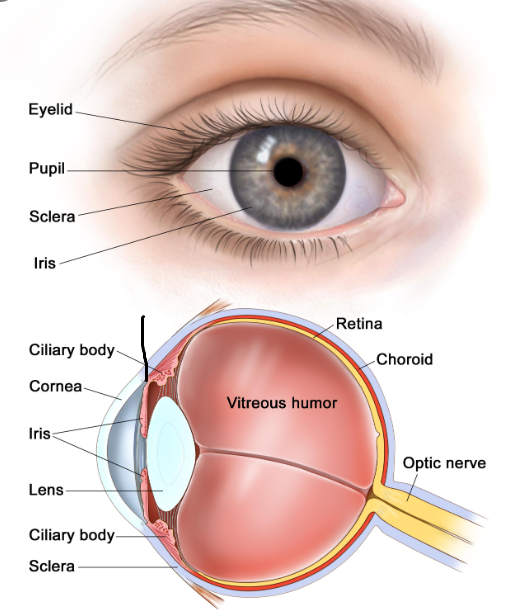
Structure of the Human Eye
CORNEA:
- It is the first part of the eye.
- It is located at the front portion of the eye.
- It is the transparent window that bulges outwards (having a convex shape).
- It is responsible for the maximum refraction (bending) of the light that enters the eye.
IRIS:
- Behind the cornea is a ring-shaped membrane called the iris.
- It is the coloured part of the eye.
- It has an adjustable circular opening that is located at the centre of the iris, called the pupil.
PUPIL:
- The pupil regulates and controls the amount of light entering the eye.
- A clear watery fluid called the aqueous humor fills the space between the cornea and the iris.
- Aqueous humor nourishes the cornea and the lens and gives the eye its shape.
- Situated behind the iris and pupil is a colorless, transparent structure called the crystalline lens
THE LENS:
- It is made of a jelly type transparent material and is a biconvex structure.
- The eye lens forms an inverted real image of the object on the retina.
RETINA:
- The screen of the eye is referred to as retina because the light rays come through the pupil and pass through the lens and converge on a screen called retina.
- Retina is the light-sensitive inner lining of the back of the eye.
SUSPENSORY LIGAMENT:
- The ciliary muscle and lens are supported by the suspensory ligament.
- Suspensory ligaments are elastic-like structures present in the eye that helps to keep the lens in its position.
- The other end of the suspensory ligament is connected to the ciliary muscles.
CILIARY MUSCLES:
- It surrounds the lens.
- Ciliary muscles determine the shape of the lens.
- They help in adjusting the focal length of the lens by contraction or relaxing. Vitreous humour lies behind the lens and forms the bulk of the eye.
- It is a dense, clear, jelly like fluid which helps to maintain the shape of the eye and it also refracts light onto the retina.
OPTIC NERVES:
- There are some nerves that connect the retina with the brain and it is called the optic nerves.
- It is located at the back of the eye. Optic nerves are bundles of over one million nerves fibers that carry visual messages from the retina to the brain.
BLIND SPOT: Blind spot is the small region where the optic nerve and the retina meet. It has no sensory organs.
EYELIDS: Protect the eye from dust and other foreign particles.
Working of Eye
- Basic working of a human eye is similar to a camera.
- Light reflects off from the objects and enters the eyeball through a transparent layer of tissue at the front of the eye called the cornea.
- The cornea bends the light rays through the pupil - the dark opening in the center of the colored portion of the eye.
- The adjusted light passes through the eye's natural crystalline lens.
- Since the eye lens is convex in nature, the resulting image is real, small, and inverted. This image is formed on the retina.
- The retina converts these light rays into electrical signals that are relayed to the brain via the optic nerve. The brain processes the information it receives, as a result, we can see.
Role of Iris and Pupil
- The eye works much the same as a camera.
- The shutter of a camera can close or open depending upon the amount of light needed to expose the film in the back of the camera. The eye, like the camera shutter, operates in the same way. The iris and the pupil control how much light to let into the back of the eye.
- The iris contains muscles that allow the pupil to become large and small.
- The iris actually regulates the amount of light entering the eye by adjusting the size of the pupil opening.
- If the amount of light rays incident on the eye is high, then the iris contracts thereby reducing the size of the pupil.
- This will reduce the intensity of light (allow only a small amount of light to pass through the pupil) thus protecting our eyes from damage.
- Similarly, if the intensity of the incident light is low, then the iris widens and the pupil dilates or gets bigger so as to facilitate entrance of sufficient amount of light thereby enabling us to view the image clearly.
- Iris monitors the amount of light entering our eye by changing the size of the pupil.
- In bright light, the iris closes (or contracts) and makes the pupil opening smaller to restrict the amount of light that enters the eye.
- In dim light, the iris expands (or dilates) and makes the pupil opening larger to increase the amount of light that enters the eye.
- But, it takes time for iris and pupil to change its size.
Why are we not able to see the things clearly when we come out of a darkroom for example while coming out of a movie hall?
When we are in the dark, pupil size is bigger. As we come out of the dark room, its size needs to become smaller. For that time-interval person is unable to see. Similarly, we are not able to see objects clearly for some time when you enter from bright light to a room with dim light. When the light is very bright, the iris contracts the pupil to allow less light to enter the eye. However, in dim light the iris expands the pupil to allow more light to enter the eye. As we come out of a bright room, its size needs to become larger. For that time-interval person is unable to see.
The eye lens is composed of a fibrous, jelly-like material. Its curvature can be modified to some extent by the ciliary muscles. The change in the curvature of the eye lens can thus change its focal length. When the muscles are relaxed, the lens becomes thin. Thus, its focal length increases. This enables us to see distant objects clearly. When you are looking at objects closer to the eye, the ciliary muscles contract. This increases the curvature of the eye lens. The eye lens then becomes thicker. Consequently, the focal length of the eye lens decreases. This enables us to see nearby objects clearly.
The ability of the eye lens to adjust its focal length is called accommodation. However, the focal length of the eye lens cannot be decreased below a certain minimum limit. Try to read a printed page by holding it very close to your eyes. You may see the image being blurred or feel strain in the eye. To see an object comfortably and distinctly, you must hold it at about 25 cm from the eyes. The minimum distance, at which objects can be seen most distinctly without strain, is called the least distance of distinct vision. It is also called the near point of the eye. For a young adult with normal vision, the near point is about 25 cm. The farthest point upto which the eye can see objects clearly is called the far point of the eye. It is infinity for a normal eye. You may note here a normal eye can see objects clearly that are between 25 cm and infinity. Sometimes, the crystalline lens of people at old age becomes milky and cloudy. This condition is called cataract. This causes partial or complete loss of vision. It is possible to restore vision through a cataract surgery.
Sometimes, the eye may gradually lose its power of accommodation. In such conditions, the person cannot see the objects distinctly and comfortably. The vision becomes blurred due to the refractive defects of the eye. There are mainly three common refractive defects of vision. These are (i) myopia or near-sightedness, (ii) Hypermetropia or far-sightedness, and (iii) Presbyopia. These defects can be corrected by using suitable spherical lenses.
Myopia
Myopia is also known as near-sightedness. A person with myopia can see nearby objects clearly but cannot see distant objects distinctly. A person with this defect has the far point nearer than infinity. Such a person may see clearly upto a distance of a few metres. In a myopic eye, the image of a distant object is formed in front of the retina [Fig. 2 (b)] and not at the retina itself. This defect may arise due to (i) excessive curvature of the eye lens, or (ii) elongation of the eyeball. This defect can be corrected by using a concave lens of suitable power. This is illustrated in Fig. 2 (c). A concave lens of suitable power will bring the image back onto the retina and thus the defect is corrected. 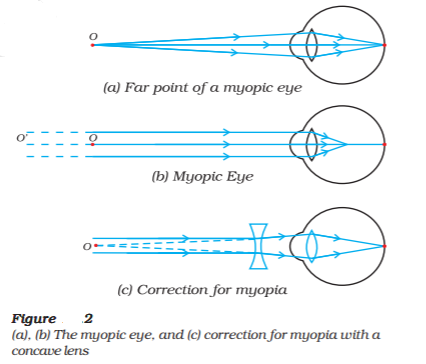
Hypermetropia
Hypermetropia is also known as far-sightedness. A person with hypermetropia can see distant objects clearly but cannot see nearby objects distinctly. The near point, for the person, is farther away from the normal near point (25 cm). Such a person has to keep a reading material much beyond 25 cm from the eye for comfortable reading. This is because the light rays from a closeby object are focussed at a point behind the retina as shown in Fig. 3 (b). This defect arises either because (i) the focal length of the eye lens is too long, or (ii) the eyeball has become too small. This defect can be corrected by using a convex lens of appropriate power. This is illustrated in Fig. 3 (c). Eye-glasses with converging lenses provide the additional focussing power required for forming the image on the retina.

Presbyopia
The power of accommodation of the eye usually decreases with ageing. For most people, the near point gradually recedes away. They find it difficult to see nearby objects comfortably and distinctly without corrective eye-glasses. This defect is called Presbyopia. It arises due to the gradual weakening of the ciliary muscles and diminishing flexibility of the eye lens. Sometimes, a person may suffer from both myopia and hypermetropia. Such people often require bi-focal lenses. A common type of bi-focal lenses consists of both concave and convex lenses. The upper portion consists of a concave lens. It facilitates distant vision. The lower part is a convex lens. It facilitates near vision. These days, it is possible to correct the refractive defects with contact lenses or through surgical interventions.
Cataract
Cataract is a condition of partial or complete loss of vision. During old age, the crystalline lens of some people becomes milky and cloudy. This causes partial or complete loss of vision. It is possible to restore vision through a cataract surgery. In this surgery, the cloudy lens is removed and replaced with an artificial lens.
Why do we have two eyes for vision and not just one?
There are several advantages to having two eyes instead of one. It gives a wider field of view. A human being has a horizontal field of vision of about 150 degrees with one eye and of about 180 degrees with two eyes. This gives a better judgment of distance of object. The ability to detect faint objects is, of course, enhanced with two detectors instead of one. As our eyes are separated by a few centimetres, each eye sees a slightly different image.
1. Draw ray diagrams each showing
(i) myopic eye and
(ii) hypermetropic eye.
2. (a) The near point of a hypermetropic person is at `75 cm` from the eye. What is the power of the lens required to enable him to read clearly a book held at `25 cm` from the eye ?
(b) In what way does the corrective lens help the person above ? Does the lens magnify objects held near the eye ?
( c) The person above prefers to remove his spectacles while looking at the sky. Explain why ?
3. A child while playing with his father's spectacles, burnt a hole in a piece of tissue paper by focussing the image of the sun on the paper.
(a) Name the defect of vision his father is suffering from.
(b) List two causes of the defect.
( c) Draw a ray diagram to show this defect may be corrected using a suitable lens.
Light rays get refracted through a rectangular glass slab. For parallel refracting surfaces, as in a glass slab, the emergent ray is parallel to the incident ray. However, it is slightly displaced laterally. How would light get refracted through a transparent prism? Consider a triangular glass prism. It has two triangular bases and three rectangular lateral surfaces. These surfaces are inclined to each other. The angle between its two lateral faces is called the angle of the prism. To study the refraction of light through a triangular glass prism we can perform an activity.
- Fix a sheet of white paper on a drawing board using drawing pins.
- Place a glass prism on it in such a way that it rests on its triangular base. Trace the outline of the prism using a pencil.
- Draw a straight line PE inclined to one of the refracting surfaces, say AB, of the prism
- Fix two pins, say at points P and Q, on the line PE as shown in Fig. 4.
- Look for the images of the pins, fixed at P and Q, through the other face AC.
- Fix two more pins, at points R and S, such that the pins at R and S and the images of the pins at P and Q lie on the same straight line.
- Remove the pins and the glass prism.
- The line PE meets the boundary of the prism at point E (see Fig. 4). Similarly, join and produce the points R and S. Let these lines meet the boundary of the prism at E and F, respectively. Join E and F.
- Draw perpendiculars to the refracting surfaces AB and AC of the prism at points E and F, respectively.
- Mark the angle of incidence (`anglei`), the angle of refraction (`angler`) and the angle of emergence (`anglee`) as shown in Fig. 4.
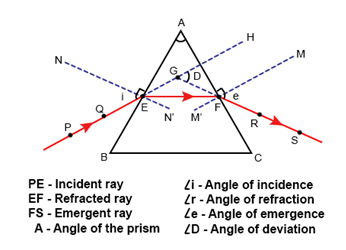
Here PE is the incident ray, EF is the refracted ray and FS is the emergent ray. A ray of light is entering from air to glass at the first surface AB. The light ray on refraction has bent towards the normal. At the second surface AC, the light ray has entered from glass to air. Hence it has bent away from normal. The peculiar shape of the prism makes the emergent ray bend at an angle to the direction of the incident ray. This angle is called the angle of deviation. In this case `angleD` is the angle of deviation.
Difference in refraction of light through glass prism and glass slab
Glass slab has parallel refracting surfaces while a glass prism does not have parallel refracting surfaces. Therefore, In case of glass slab, the incident ray emerges parallel to the emergent ray, while in case of prism; the incident ray makes an angle with the emergent ray, i.e. angle of deviation (so, it's not parallel).
Newton proved that white light is made up of 7 colours namely VIBGYOR. He proved it by using a glass prism. (Fig. 5)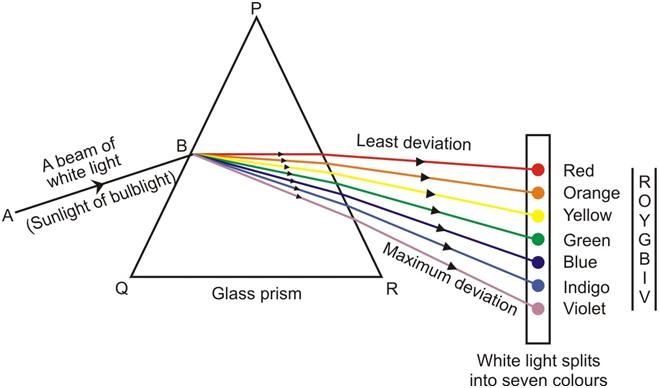
- When a beam of white light is passed through a glass prism, it is split up into a band of colours called spectrum. This phenomenon is called dispersion of white light.
- The spectrum of white has the colours violet, indigo, blue, green, yellow, orange and red (VIBGYOR).
- He allowed sunlight to pass through the prism. He saw the white light was split into 7 different colours.
- We can define dispersion as the splitting of white light into 7 colours on passing through a transparent substance like glass prism is called dispersion of light.
- The sequence of seven colours obtained from dispersion of white light is called spectrum of white light.
Why do we get different colours when white light is dispersed by a prism.
Different colours of light bend through different angles with respect to the incident ray, as they pass through a prism (on refraction). The red light bends the least while the violet the most. Thus the rays of each colour emerge along different paths and thus become distinct. It is the band of distinct colours that is seen in a spectrum.
Isaac Newton was the first to use a glass prism to obtain the spectrum of sunlight. He tried to split the colours of the spectrum of white light further by using another similar prism. However, he could not get any more colours. He then placed a second identical prism in an inverted position with respect to the first prism. This allowed all the colours of the spectrum to pass through the second prism. He found a beam of white light emerging from the other side of the second prism. This observation gave Newton the idea that the sunlight is made up of seven colours. Any light that gives a spectrum similar to that of sunlight is often referred to as white light. Recombination of the seven colours of the dispersed white light to get white light is known as Recomposition of light.(Fig. 6)
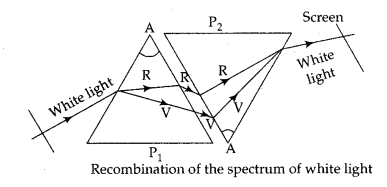
Applications of Dispersion (Formation of Rainbow)
Rainbows are generally formed after rains. It is a concentric coloured circular arc in the sky when the sun rays fall on rain drops during or after a shower.
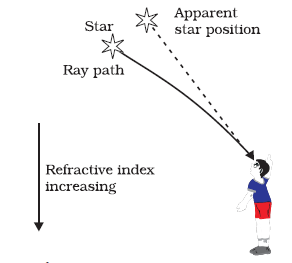
- The small droplets of rain water which remain suspended in air just after the rains act like a prism. The white light enters from air to water medium.
- When white light from the sun enters a spherical raindrop, the light is refracted and dispersed. The different colours of light are bent through different angles.
- When different colours of light fall back on the inner surface of the water drop, it (water drop) reflects them (different colours of light) internally (total internal reflection).
- The water drop finally refracts the different colours of light again when it comes out of raindrop.
- Due to the dispersion of light and internal reflection, different colours reach the observer's eye, and the observer can see a rainbow.
Rainbow is formed opposite to the sun. Raindrops act like prism. Rainbow is an example of natural dispersion.
When a light ray travels from one medium to another, there is a bending of the ray. This happens because the two mediums have different refractive index. Let us now consider the medium air. Air can be cold as well as hot. When air is hot, its refractive index is less whereas when air is cold, its refractive index is more. We can thus say that the refractive index of air depends on temperature. Therefore, during winter, the air is cold therefore the refractive index of air will be more and in summer, the air is hot and therefore it's refractive index is less.
Let us now consider a situation where light rays move from hot air towards cold air; what happens to the light ray? Does it bend? Here we can see that there is a bending of the light ray because the refractive index of hot air and cold air is different.
Similarly, when light rays travel from space to reach the surface of earth, it travels through a layer of atmosphere. The temperature of the atmosphere varies at different places. It has varying temperature and thus has a varying refractive index.
When a light ray enters the atmosphere, there is refraction of the light ray and hence travels along a curved path as there is continuous change of temperature in the atmosphere, so the ray undergoes continuous refraction.
Therefore, the path of light is bending continuously due to continuous refraction. This is called atmospheric refraction.Variation of temperature is different at different times. This results in a change in path of light at different times.
Let's take a look at some phenomena associated with atmospheric refraction.
1) Apparent position of stars
2) Advance sunrise and delayed sunset
3) Twinkling of stars
4) Planets don't twinkle
5) Flickering of flame
Why does the star appear slightly higher than its actual position?
Light from stars undergoes continuous refraction as it enters the earth's atmosphere.
Since the refracted ray bends towards the normal, the stars appear at different positions and appear slightly higher than their actual positions. The apparent position of the star also changes gradually due to change in the earth's atmosphere. Therefore, the apparent position of the star fluctuates. As a result, the path of light from the star varies.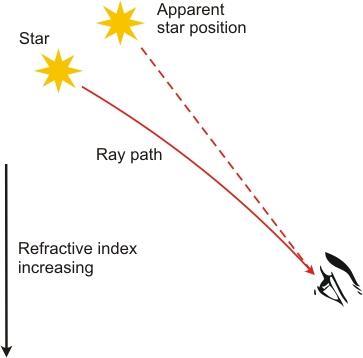
Advance sunrise and delayed sunset
The Sun is visible to us about 2 minutes before the actual sunrise, and about 2 minutes after the actual sunset because of atmospheric refraction. The density of the air in the atmosphere is not the same everywhere. At some places it is higher and in some places it is less. The higher the density, the greater is the refractive index of air. At sunrise or at sunset, the sun is either at the horizon or below the horizon. Hence the light rays from the sun have to travel a larger distance through the atmosphere. As the rays travel from rarer to denser medium, they start bending more and more towards the normal (observer). Hence, there is a change in the altitude of the sun and they appear at a higher position than they actually are. The sun is visible to us about 2 minutes before actual sunrise minutes and 2 minutes after sunset because of atmospheric refraction. The apparent flattening Sun's disc at sunrise and sunset is also due to the same phenomenon.
Twinkling of Stars
The twinkling of stars is due to the atmospheric refraction. Light from the stars undergoes continuous atmospheric refraction as it passes through the layers of the atmosphere. Since the atmosphere bends the refracted rays towards the normal, the apparent position of the star is slightly different from its actual position. So, the star appears slightly above than its actual position when viewed near the horizon. The apparent position of the star changes gradually due to the change in the earth's atmosphere. Therefore, the apparent position of the star changes and the path of light from the star also vary. Due to this change in the brightness of light from the star, the star appears to be twinkling.
Planets don’t Twinkle
The Planets are very close to earth as compared to the stars. So, the intensity of light we receive from the planets is very large. Therefore, small variations in their positions and brightness are not noticeable. Thus, the brightness of the planet seems to remain the same. The continuously changing earth's atmosphere is unable to cause variations in the light rays coming from the planet. Therefore, planets do not twinkle.
Flickering of flame
The air above the fire is hotter than surrounding air. The hotter air is lighter(less dense) than the cooler air above it and has a refractive index slightly less than that of the cooler air above it. Since the physical conditions of the refracting medium (air) are not stationary, the apparent position of the objects, as seen through the hot air, fluctuates.
The interplay of light with objects around us gives rise to several spectacular phenomena in nature. The blue colour of the sky, colour of water in the deep sea, the reddening of the sun at sunrise and the sunset are some of the wonderful phenomena we are familiar with. In the previous class, you have learnt about the scattering of light by colloidal particles. The path of a beam of light passing through a true solution is not visible. However, its path becomes visible through a colloidal solution where the size of the particles is relatively larger.
Tyndall Effect
The earth’s atmosphere is a heterogeneous mixture of minute particles. These particles include smoke, tiny water droplets, suspended particles of dust and molecules of air. When a beam of light strikes such fine particles, the path of the beam becomes visible. The light reaches us, after being reflected diffusely by these particles. The phenomenon of scattering of light by the colloidal particles gives rise to the Tyndall effect. This phenomenon is seen when a fine beam of sunlight enters a smoke-filled room through a small hole. Thus, scattering of light makes the particles visible. Tyndall effect can also be observed when sunlight passes through a canopy of a dense forest. Here, tiny water droplets in the mist scatter light. The colour of the scattered light depends on the size of the scattering particles. Very fine particles scatter mainly blue light while particles of larger size scatter light of longer wavelengths. If the size of the scattering particles is large enough, then, the scattered light may even appear white.
Why is the colour of the clear Sky Blue?
The molecules of air and other fine particles in the atmosphere have size smaller than the wavelength of visible light. These are more effective in scattering light of shorter wavelengths at the blue end than light of longer wavelengths at the red end. The red light has a wavelength about 1.8 times greater than blue light. Thus, when sunlight passes through the atmosphere, the fine particles in air scatter the blue colour (shorter wavelengths) more strongly than red. The scattered blue light enters our eyes. If the earth had no atmosphere, there would not have been any scattering. Then, the sky would have looked dark. The sky appears dark to passengers flying at very high altitudes, as scattering is not prominent at such heights.
Why are the danger signal lights red in colour?
The ‘danger’ signal lights are red in colour because the red is least scattered by fog or smoke. The wavelength of red light is more than any other colour. So, red light is able to travel the longest distance through fog, rain and the alike. Therefore, it can be seen in the same colour at a distance.
Why the Sun appear reddish during the sunset and white during sunrise?
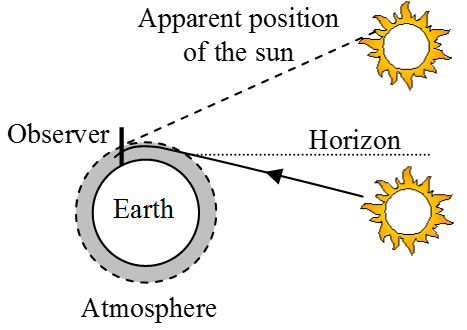
Light from the Sun near the horizon passes through thicker layers of air and larger distance in the earth’s atmosphere before reaching our eyes (Fig. 12). However, light from the Sun overhead would travel a relatively shorter distance. At noon, the Sun appears white as only a little of the blue and violet colours are scattered. Near the horizon, most of the blue light and shorter wavelengths are scattered away by the particles. Therefore, the light that reaches our eyes is of longer wavelengths. This gives rise to the reddish appearance of the Sun.
The medium of air becomes rarer as we start moving at high altitudes. Due to the absence of air molecules or any other particles, there is no scattering of light. That is why, the sky appears dark from space or to an astronaut flying at very high altitudes.
Experiment to Prove Scattering of Light
- Place a strong source (S) of white light at the focus of a converging lens (`L_1`). This lens provides a parallel beam of light.
- Allow the light beam to pass through a transparent glass tank (T) containing clear water.
- Allow the beam of light to pass through a circular hole (c) made in cardboard. Obtain a sharp image of the circular hole on a screen (MN) using a second converging lens (`L_2`), as shown in Fig. 13.
- about 200 g of sodium thiosulphate (hypo) in about 2L of clean water taken in the tank. Add about 1 to 2 mL of concentrated sulphuric acid to the water.
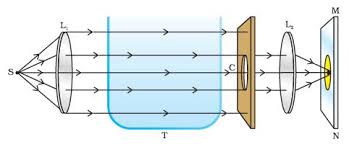
We will observe fine microscopic sulphur particles precipitating in about 2 to 3 minutes. As the sulphur particles begin to form, there will be blue light from the three sides of the glass tank. This is due to scattering of short wavelengths by minute colloidal sulphur particles. Observe the colour of the transmitted light from the fourth side of the glass tank facing the circular hole. It is interesting to observe at first the orange red colour and then bright crimson red colour on the screen will be present. This experiment demonstrates the scattering of light that helps in understanding the bluish colour of the sky and the reddish appearance of the Sun at the sunrise or the sunset
1. Why do we see a rainbow in the sky only after rainfall?
2. Explain the refraction of light through a triangular glass prism using a labelled ray diagram. Hence define the angle of diviation.
3. How does refraction take place in the atmosphere? Why do stars twinkle but not the planets?
- The ability of the eye to focus on both near and distant objects, by adjusting its focal length, is called the accommodation of the eye.
- The smallest distance, at which the eye can see objects clearly without strain, is called the near point of the eye or the least distance of distinct vision. For a young adult with normal vision, it is about 25 cm.
- The common refractive defects of vision include myopia, hypermetropia and presbyopia. Myopia (short-sightedness – the image of distant objects is focussed before the retina) is corrected by using a concave lens of suitable power. Hypermetropia (far-sightedness – the image of nearby objects is focussed beyond the retina) is corrected by using a convex lens of suitable power. The eye loses its power of accommodation at old age.
- The splitting of white light into its component colours is called dispersion.
- Scattering of light causes the blue colour of sky and the reddening of the Sun at sunrise and sunset.
1. What is meant by accommodation of the eye ?
2. A person with a myopic eye cannot see objects beyond `1.2 m` distinctly. What should be the type of corrective lens to restore proper vision ?
3. For a normal eye, the least distance of distinct vision is……..and far point is………… .
4. A student has difficulty reading the blackboard while sitting in the last row. What could be the defect the child is suffering from? How can it be corrected?
5. The human eye can focus objects at different distances by adjusting the focal length of the eye lens. This is due to
6. The human eye forms the image of an object at its
7. For a normal eye, the least distance of distinct vision is
8. The change in focal length of an eye lens is caused by the action of the
9. A person wears eye glasses with a power of `-5.5 D` for distance viewing. His doctor prescribes a correction of `+ 1.5 D` for his near vision. What is the focal length of the lens used for correcting (i) distant vision and (ii) near vision?
10. The far point of a myopic person is 80 cm in front of the eye. What is the nature and power of the lens required to correct the problem?
11. Make a diagram to show how hypermetropia is corrected. The near point of a hypermetropic eye is `1 metre`. What is the power of the lens required to correct this defect ? Assume that the near point of the normal eye is `25 cm`.
12. What happens to the image distance in the eye when we increase the distance of an object from the eye ?
13. Why do stars twinkle?
14. Explain why the planets do not twinkle?
15. Why does the Sun appear reddish early in the morning?
16. Why does the sky appear dark instead of blue to an astronaut?
1. To focus the image of a nearby object on the retina of an eye :
- The distance between eye-lens and retina is increased
- The distance between eye-lens and retina is decreased
- The thickness of eye-lens is decreased
- The thickness of eye-lens is increased
Answer: D
2. How does the eye change in order to focus on near or distant objects ?
- The lens moves in or out
- The retina moves in or out
- The lens becomes thicker or thinner
- The pupil gets larger or smaller
Answer: C
3. Though a woman can see the distant objects clearly, she cannot see the nearby objects clearly. She is suffering from the defect of vision called :
- Long-sight
- Short-sight
- Hind-sight
- Mid-sight
Answer: A
4. A man driving a car can read a distant road sign clearly but finds difficulty in reading the odometer on the dashboard of the car. Which of the following statement is correct about this man ?
- The near point of his eyes has receded away.
- The near point of his eyes has come closer to him.
- The far point of his eyes has receded away.
- The far point of his eyes has come closer to him.
Answer: A
5. With both eyes open, a person's field of view is about :
- `90^(@)`
- `150^(@)`
- `180^(@)`
- `360^(@)`
Answer: C
6. A beam of white light is shone onto a glass prism. The light cannot be :
- Deviated
- Dispersed
- Focused
- Refracted
Answer: C
7. The coloured light having the maximum speed in glass prism is :
- Blue
- Green
- Violet
- Yellow
Answer: D
8. Due to atmospheric refraction of sunlight, the time from sunrise to sunset is lengthened by about :
- 6 minutes
- 2 minutes
- 4 minutes
- 5 minutes
Answer: C
9. Which of the following is not caused by the atmospheric refraction of light ?
- Twinkling of stars at night
- Sun appearing higher in the sky than it actually is
- Sun becoming visible two minutes before actual sunrise
- Sun appearing red at sunset
Answer: D
10. Why are danger signals red in colour ?
- is scattered the most by smoke or fog
- is scattered the least by smoke or fog
- is absorbed the most by smoke or fog
- moves fastest in air.
Answer: B
1. What happens when a beam of sunlight enters a dusty room through a window ? Explain your answer.
Answer: NA
2. Explain why, when the sun is overhead at noon, it appears white, but when the same sun is near the horizon at sunset, it appears red.
Answer: NA
3. Explain the phenomenon of dispersion of white light through a glass prism, using suitable ray diagram.
4. (a) The far point of a myopic person is `80 cm`. In front of the eye. What is the power of the lens required to enable him to see very distant objects clearly ?
(b) In what way does the corrective lens help the person above ? Does the lens magnify very distant objects ? Explain carefully.
(c) The person above prefers to remove his spectacles while reading a book. Explain why ?
5. Nooper needs a lens of power `- 4.5 D` for correction of her vision.
(a) What kind of defect in vision is she suffering from ?
(b) What is the focal length and nature of corrective lens ?
(c) Draw ray diagrams showing the defected eye and correction for the defect.
(d) What are the causes of this defect ?
6. Draw ray diagrams each showing
(i) myopic eye and
(ii) hypermetropic eye.
7. Assertion `:` The stars twinkle while the planets do not.
Reason `:` The stars are much bigger in size than the planets.
8. (a) For a normal eye, what is the least distance of distinct vision ?
(b) What is the maximum power of accomodation of a normal eye ?
9. (a) Why do spectrum colours recombine on passing through two prisms oriented duly ?
(b) What is the essential condition for observing a rainbow ?
10. With the help of ciliary muscles the human eye can change its curvature and thus alter the focal length of its lens. State the changes that occur in the curvature and focal length of the eye lens while viewing
(a) a distance object,
(b) nearby objects.
Explain, why a normal eye is not able to see distincly the objects placed closer than 25 cm, without putting any strain on the eye.
1. What is the difference in colours of the sun observed during sunrise/sunset and noon? Give explanation for each.
2. (a) A student cannot see clearly a chart hanging on a wall placed at a distance of 3m from his eyes. Name the defect of vision he is suffering from. Draw a ray diagram to illustrate this defect. List its two possible causes.
(b) Draw a ray diagram to show how this defect may be corrected using a lens of appropriate focal length.
(c) What do you mean by the 'Power of Accommodation' of human eye?
3. Explain giving reason why the sky appears blue to an observer from the surface of the earth? What will the colour of the sky be for an astronaut staying in the international space station orbiting the earth? Justify your answer giving reason.
4. Due to gradual weakening of ciliary muscles and diminishing flexibility of the eye lens, a certain defect of vision arises. Write the name of this defect. Name the type of lens required by such persons to improve the vision. Explain the structure and function of such a lens.
5. (a) A student suffering from myopia is not able to see distinctly the objects placed beyond `5 m`. Two possible reasons due to which this defect of vision may have arisen. With the help of ray diagrams, explain :
(i) Why the student is unable to see distinctly the objects placed beyond `5 m` from his eyes.
(ii) The type of corrective lens used to restore proper vision and how this defect is corrected by the use of this lens.
(b) If in this case, numerical value of focal length of corrective lens is `5 m`, find the power of the lens as per the new cartesion sign convention.
6. (a) Write the function of each of the following parts of human eye :
(i) Cornea
(ii) Iris
(iii) Crystalline lens
(iv) Ciliry muscles
7. (a) What is presbyopia ? State its cause. How is it corrected ?
(b) Why does the sun appear reddish early in the morning ? Explain with the help of a labelled diagram.
8. What happens to the image distance in the normal human eye when we decrease the
distance of an object, say 10 m to 1 m? Justify your answer.
9. A person is unable to see objects distinctly placed within 50 cm from his eyes.
(a) Name the defect of vision the person is suffering from and list its two possible causes.
(b) Draw ray diagram to show the defect in the above case.
(c) Mention the type of lens used by him for the correction of the defect and calculate its power. Assume that the near point for the normal eye is 25 cm.
(d) Draw a labelled diagram for the correction of the defect in the above case.
10. What is meant by scattering of light ?